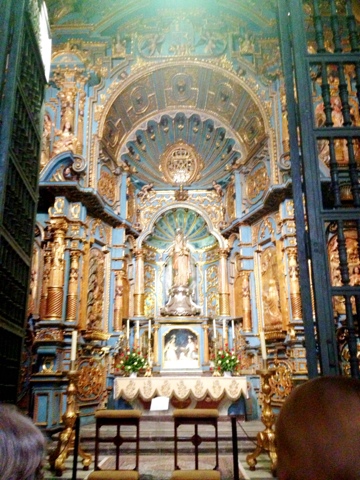This is a typical example of the architecture that effectively has made the whole city a world heritage site.
Fun fact: did you know Lima gets about 10mm or rain annually? Instead of rain there is a constant cloud and light drizzle almost all day. It keeps everything green and comfortably moist.
Peru was founded to be the capital of Francisco Pizarro's new colony of Peru. It a neatly planned and sprawling city much like that of any spanish City. It grew to be incredibly wealthy and powerful quite quickly. It was the most elegant and cosmopolitan city in its colonial and republic heyday in South America. To this day, it's economy is in 50% minerals, particularly silver and copper with the rest being spread across agriculture, textiles and tourism.
It has an incredible spiritual history as well with 5 major Peruvian saints coming from the colonial era. St Rose of Lima and St Martin de Porres, contemporaries, and good friends despite their different social status. St Francisco Saldano, a major figure in Missonary outreach, St Turibio de Morojeveo, the second bishop of Lima and a good, holy shepherd to every Peruvian. The last one I can't remember off the top of my head but I will correct this later.
We spent the day visiting the major churches and places that St Rose and St Martin lived in. First stop however, was to the Franciscan monastery and San Antonio church.
This side altar is one of the more simple ones. It is typical colonial Spanish, hand carved from jungle hardwoods like mahogany in this case which is imported from Central America. We then spent some solid time in San Domingo monastery and Church where St Martin De Porres lived and worked.
This little cupboard under the stairs was where St Martin spent a lot of time in prayer and arguing with the devil. Casually. He was an incredibly humble and gifted healer. Her was the illegitimate child of an African slave and Spanish Father. He spent his life in prayer and serving the Dominican order as a cleaner, cook and infirmary attendant. They eventually accepted him as a brother. Lots of great stories that I don't have time to go into at the moment.
These Dominicans founded the oldest university in the Americas, San Marco and I am moving in.
This room was the meeting room of the order where they founded the university. From that pulpit, a PhD candidate would present their thesis to a panel of three jurors. You can't quite see it, but there was a little bench under the pulpit where the examiner would sit and ask questions. I'm defending my Thesis here. No arguments.
St Roses' body is also in the crypt here. Her skull is over at the Church built next to her house which is now a convent. But before we got there, we went to this insanely beautiful Baroque Jesuit church of San Pedro.
This is a side altar dedicated to St Ignatius, it is solid mahogany and festooned with Peruvian gold leaf. When the Jesuits were suppressed in the 18th Century, the church was closed for about a century. By some miracle people forgot just how much gold was in here and did not loot the place. But my favourite was this side altar...
It's a Marian altar and it a bit younger than the rest of the church, making Rococo which is Baroque but on steroids.
So we then headed over to St Rose's Church. She came from a wealthy family and wanted to join the Dominicans but her family wouldn't hear of it. She practiced increasingly harsher penitence and self-mortification. She built herself a tiny anchorite cell...
And spent her days when she was not praying working in the infirmary. She fasted severely and physically pushed herself beyond any human tolerance dying at age 31 from turburculosis.
This is her skull in the Church:
The cathedral has a museum displaying about 200 artefacts from people's homes donated to the Church, things like...
Then we headed back to the retreat house absolutely dead, had mass and fought hard to stay awake and then dinner and bed.
Tomorrow we see Lima's other side.



















No comments:
Post a Comment